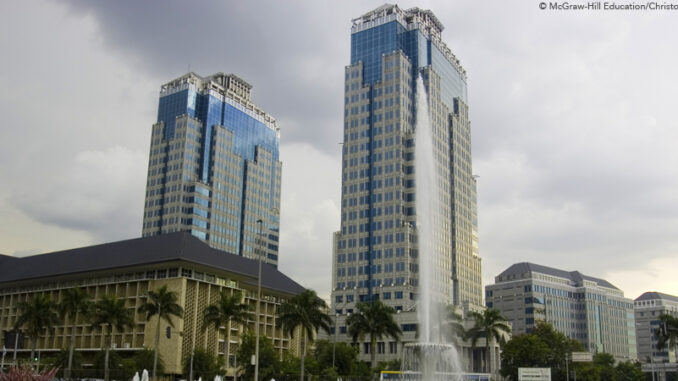
Indonesia’s New Capital
What’s the capital of Indonesia? If you say Jakarta, you’d now be wrong – as of last week, the Indonesian capital has been changed from Jakarta to Borneo.
Why the change? The current capital, Jakarta, is the fastest-sinking cities in the world. It sits on swampy land and has thirteen rivers running through it, so flooding is common. In fact, at its current rate of sinking–about 25 centimeters per year, or double the global average–experts say that about 95 percent of North Jakarta will be completely submerged by 2050. The city has also grown so quickly that it is overrun by industry, pollution, and congestion. It has been clear for several decades that something needs to be done, but moving the capital comes with a pretty hefty price tag: about $32 billion.
So here’s the plan. Last week, the Indonesian House of Representatives passed a bill creating the new capital, Nusantara (meaning “archipelago”), on a currently undeveloped piece of jungle in East Kalimantan, Borneo. The initial relocation efforts will focus on moving foreign embassies and international organization offices. This phase of the move will happen between 2022 and 2024. The overall relocation process, however, is expected to take until 2045.
Dig Deeper Myanmar also moved its capital in recent years. Use Internet resources to write a paragraph describing why the change was necessary.
Volcano Erupts in Tonga
Tonga is nation of 176 islands, located in the Pacific Ocean about two thousand miles east of Australia. Last week, the country suffered a massive volcanic eruption. Hunga-Tonga-Hunga-Ha’apai is an undersea volcano located about forty miles north of Tonga’s capital. It has erupted several times in recent years, but this eruption was one of the strongest in decades. Its estimated force was ten megatons. (That means the force of the eruption was five hundred times more powerful than the nuclear bomb dropped on Hiroshima in 1945.) The eruption sent a mushroom cloud of ash 100,000 feet into the sky. It also triggered a devastating tsunami that caused rising water levels as far away as the western coasts of the United States and Peru.
To make matters worse, the ash blocked satellite phone communications and the tsunami knocked out undersea fiber-optic cables. This made it very difficult for Tonga to be able to communicate with the rest of the world. Since then, cell service has been restored and the international community has been able to begin providing emergency relief supplies. Tonga is beginning to receive bottled water, shelters, generators, and communication supplies. Three people were killed by the eruption. Thick ash covered everything, including the airport and runways, which had to be cleared by hand. Ash and seawater also have contaminated the country’s drinking water supply and lowered agricultural crop yields and livestock counts.
What Do You Think? While the immediate impact of the eruption and resulting tsunami have been devastating, what effects do you think the people of Tonga will be experiencing from it one month from now? One year?
Ancient Canoe Found in Wisconsin
Last summer, a recreational scuba diver in southern Wisconsin’s Lake Mendota made an interesting discovery. The diver found a wooden dugout canoe, thought to be about 1,200 years old. The canoe was discovered by Tamara Thomsen, a maritime archaeologist. She was riding an underwater scooter in Lake Mendota with a friend in June when she saw it sticking out of the mud, thinking at first that it was a log. The canoe, which is made of basswood or walnut, is very fragile and was carefully brought to the surface recently. It is believed to have been constructed by the Effigy Mound builders, ancestors of the Ho-Chunk Nation. It is the oldest intact boat that has ever been found in Wisconsin.
Scientists say that the reason the canoe has been so well-preserved is that it was buried mostly underground and has not been exposed to the light. To keep it preserved, scientists will first have to submerge it in a tank of water mixed with biocide to kill the algae and other microorganisms. From there, it will be dipped into polyethylene glycol to prevent future deterioration. This process will take about two years. After that, it is hoped that it will find a permanent home in a new museum managed by the Wisconsin Historical Society.
